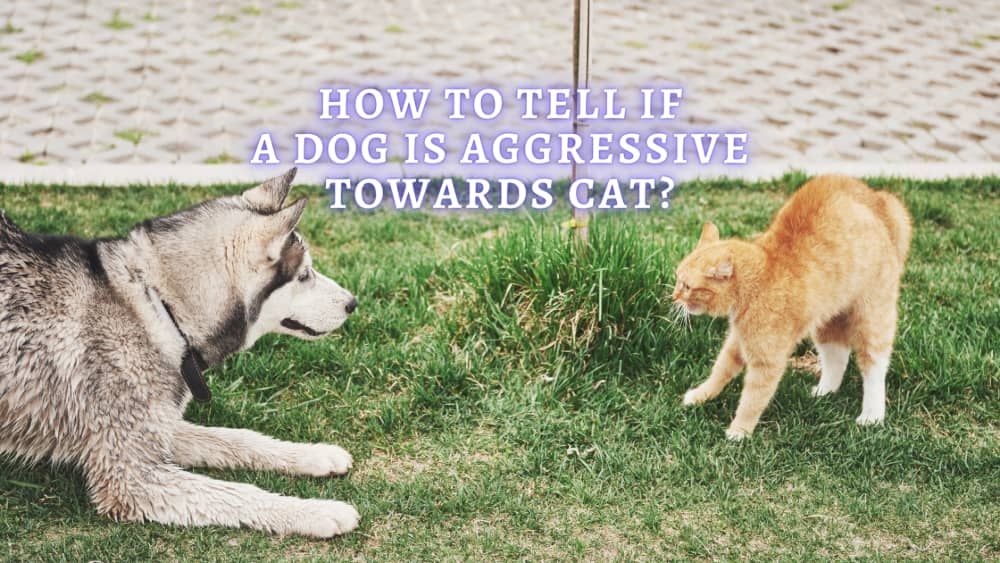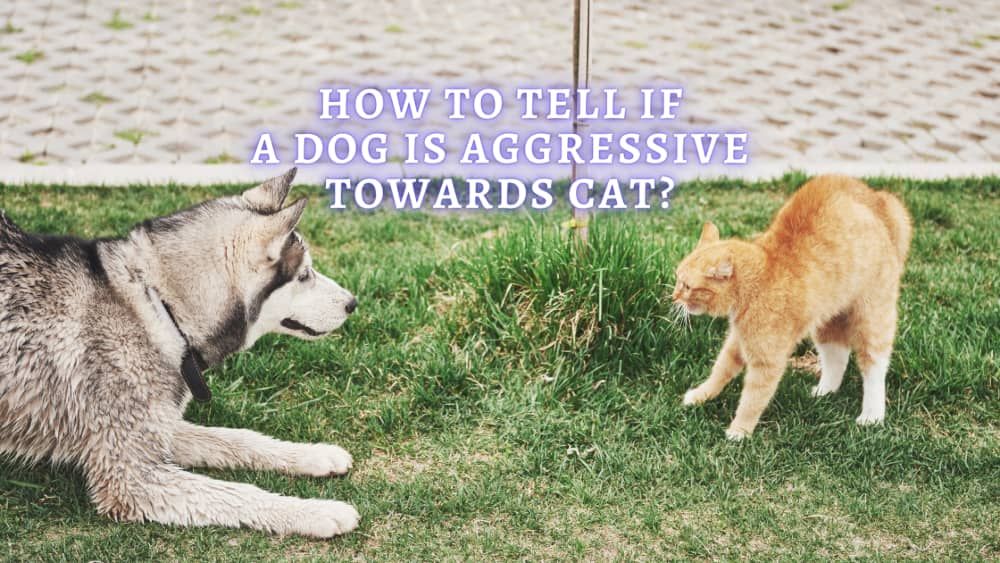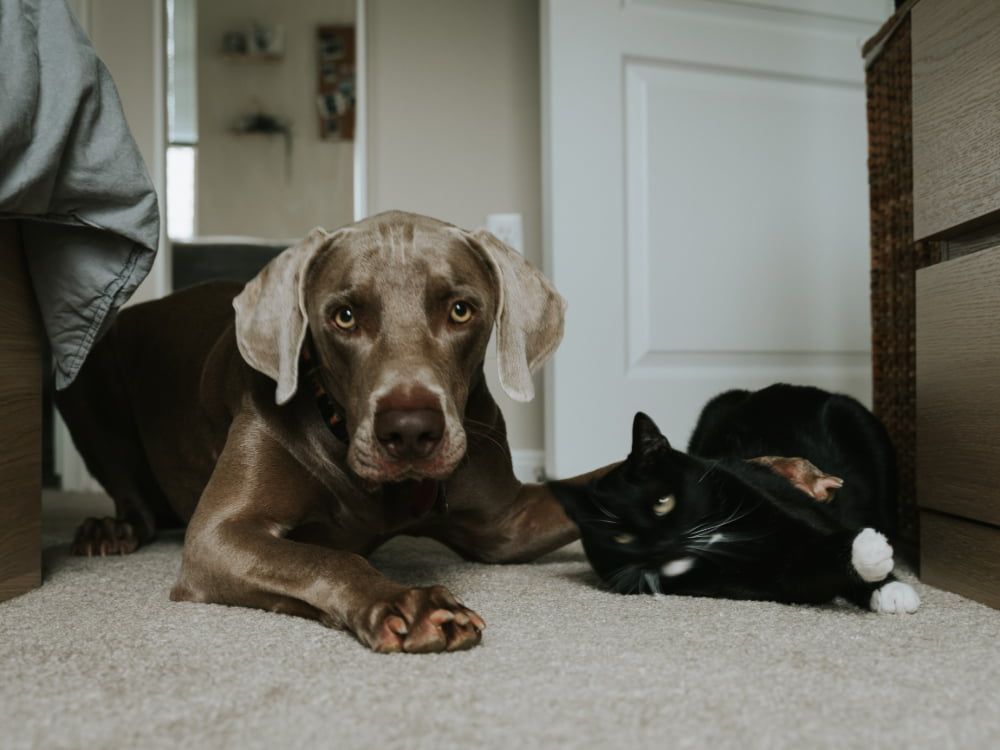


Both dogs and cats make excellent pets, so it is no wonder that many households own both species.[2] However, they do not always mix — especially if your pup is aggressive towards cats.
In this article, we will take a look at some common signs of dog aggression. When you can tell if your friend canine is aggressive, you’ll be able to keep your pets safe.
READ MORE: Best Online Dog Training Courses
What is Aggression in Dogs?
To start, it is crucial to define what aggression looks like. The signs of aggression can vary, from mild signs of stress to growling and biting, so it is essential to be aware of what the aggressive dog looks like.
Canine aggression often comes from a predatory or fearful nature. In the case of dog aggression towards cats, both aspects can be at play.
In some scenarios, your dog may have learned that the cat is scary — especially if the cat has ever reacted to your pup.
Also, your family friend might develop aggression towards cats because of their predatory behavior.
You can think of aggressive behavior as the rungs of a ladder. Starting at the bottom, a dog may display subtle signs of stress, such as:
- Lip licking.
- Yawning.
- Slow blinking.
- Turning their head away.
A canine that is aggressive towards cats because they are afraid of them might escalate their behavior until they are tucking their tail, trying to leave the situation, or frozen in place.
You can also tell if a dog shows aggression towards cats because they are chasing, snapping, or even biting them.
These are much more intense scenarios that often require extensive management and behavior modification to teach your pets how to get along and keep them safe.
A behavior consultant, such as the International Association of Animal Behavior Consultants, [1] is a great place to start if your pets are in danger. At IAABC, you can even find cat behavior consultants! Looking for a professional who works with felines and canines can be a great way to solve more severe problems.
Now that we’ve looked at how to tell if a dog is aggressive towards cats, it is time to look at some solutions! It is important to remember that your pup is not purposefully being mean to your cat, or acting out of spite. There is always an underlying function for the aggression — such as a predatory instinct or a fear — that causes this aggression.
READ MORE: Possession Aggression in Dogs
Helping Cats and Dogs Get Along
Proper Introductions
First, if you are bringing a cat into your dog’s home (or vice versa), it is important to set the two animals up for success by introducing them properly.
Don’t assume that your dog never will have a problem with your cat — it is safest and easiest to set up a proper introduction than to deal with more intense training down the road.
Dogs and cats, while both common pets, are very different species. They interact differently, which is where many concerns come into play.
Initially, you should prevent your new pet from having any contact with the other. It is stressful enough to bring a new pet home, so they must have their own space to adjust.
A great way to introduce your pets before your dog sees the cat itself is to trade blankets that smell like the other pet. This will help one pet have time to get used to the smell of the other before they have to see each other face to face.
Next, one everyone has had time to settle in and adjust to the other pets, it is time to introduce them to each other.
It is helpful to have another person to help you, as well as a leash and some food for your dog.
When your dog sees the cat, feed them a treat! We want to practice our pup’s obedience training around the cat by keeping their attention on a treat.
It is important that both animals feel safe at all times. It may be tempting to hold the two pets face to encourage them to get along, but that often pushes them over their threshold and scares them, which can make future introductions harder.
If you see any signs that your dog is being aggressive towards cats, it is a sign to take a break. Don’t be afraid to take things slowly, or contact a professional if you need to do so.
A solid background of obedience training is helpful for the dog, but an aggressive pup often needs behavioral modification rather than just obedience training to be truly successful.
If the initial introduction on a leash goes well, you can consider having your pet and cat spend more time together. It is best to make sure your dog is on a leash or under control at all times, so your feline isn’t accidentally hurt.
It’s also recommended that you don’t leave your cat and dog together at first, if ever. Our pets are often much more well-behaved when their owners are around to give them a command and treat, rather than when the animals are alone.
READ MORE: Puppy Training


Proper Training
In order to make sure your dog doesn’t display too much aggression towards a cat, proper training is very useful.
Basic obedience training will be very helpful in keeping your pup’s attention even when cats are around.
If you have not yet done any obedience training with your pet, you may want to consider taking a training class before introducing your pet to each other. You don’t get a second chance for that first introduction, so it can often help if you work on your pooch obedience training skills first.
This is important whether the dog or the cat is new to your home. Working on obedience training with a dog you have owned for a while may help to strengthen the bond between the two you share, making it easier to stop your pooch from behaving inappropriately towards a cat.
In addition, by working with a new pup on obedience skills, you’ll be able to develop a bond between the two of you right from the start, without needing to stop problems in the future.
How to Stop Aggression Towards Cats After it Starts?
It’s much easier to control a dog’s aggressive tendencies towards cats if you can introduce your cat and dog calmly and properly during the first introduction. However, if you’ve already found out that your pets aren’t getting along, there are a few things that may help.


READ MORE: Best Wireless Dog Fence
Implement Good Management Strategies
The most important thing is to remember that your animals didn’t choose one another, and it’s up to you to ensure each one feels safe.
This often involves using management strategies so the two get separate spaces, where they can leave a room without the other animal being able to chase them.
Baby gates, exercise pens, a high place where your cat can perch, and different varieties of containment systems will likely be commonplace in your home at first.
Some of these, such as the use of high-up places for a cat to sit when they do not want to be around dogs, will be important for the lifetime of your pets.
Another great management option for canines that are aggressive towards others is the use of a properly fitted muzzle.
A muzzle used for safety purposes such as this should fit a dog comfortably, with room to open their mouth and pant.
READ MORE: Best Dog Muzzles
Use Food
For best results, pups should learn that they can earn a treat when they are around cats. Using their food or other forms of treats is helpful in this case.
A process called counter-conditioning can teach a scared dog how to be comfortable in the presence of cats.
To do this, you’ll take a treat, and feed it to your dog whenever they see your cat without reacting. The goal is that your pup learns to simply watch cats, rather than chase them.
Teaching this counter-conditioning process can take a dog that would normally chase cats, and turn them into a dog that politely watches them.
Now that you’ve learned how to tell if a dog is aggressive towards cats, it’s important to put your knowledge to action. Professionals from the International Association of Animal Behavior Consultants, [1]Certification Council for Professional Dog Trainers, [4] and Karen Pryor Academy [5] can all help you to formulate training plans if you’ve determined that your dog is displaying aggression towards a cat.
FAQ
How do you stop a dog from being aggressive to cats?
A professional trainer is the best option when dealing with dog aggression towards cats, especially since the safety of the cat may be at risk.
In the meantime, you should take steps to manage aggression by keeping your dog separate from your cat. Multiple barriers, such as doorways and gates, are best.
You can also condition your dog to wear a muzzle, so they cannot physically harm your cat, should they happen to escape their part of the house.
Not all cats and dogs can learn to cohabit ate peacefully, especially if your dog is genetically predisposed to aggression. However, a professional trainer will be able to assess the situation and determine what can be done.
Can my dog be put down for attacking a cat?
The definition of dangerous dog varies greatly be region. It’s best to refer to your local laws for the most up to date information.
A city may require dogs to be declared dangerous if they attack people or other animals, including cats. There have been cases where judges have ruled that dogs attacking a cat should be euthanized for the safety of a neighborhood.
It’s best to keep your pooch under control via fences and leashes, to prevent them from attacking a cat. You can also condition your dog to wear a basket muzzle (with room for panting) as an added measure of safety.
How do I know if my dog is too aggressive?
A veterinary behaviorist is a great resource when you are trying to decide if your dog is too aggressive, because they have the knowledge and training understanding animal behavior, and the medical background to rule out physical causes of aggression.
It’s also a good idea to reference the bite scale developed by Dr. Ian Dunbar.[3] Dogs that bite at a level 4 or above are often considered extremely dangerous and difficult to rehabilitate. They will need careful management for the rest of their life.
Dogs that bite at a level 1 or 2 can often make great progress towards being a safe member of society, with the right training and precautions.
Dogs biting at a level 3 may be able to make progress, or may need lifelong management. A professional evaluation of the situations in which the bites occurred can help you make that decision.
What dog breeds are not good with cats?
Typically, any breed that has high prey drive is not good with cats. They are often spurred to chase cats when they run away, which the uncomfortable cat often does.
Smaller dogs bred for companionship are often the best choice when living with cats, since they cannot as easily cause physical harm and are not as likely to have high levels of prey drive.
There are exceptions in many cases, though, so it’s best to pick a dog that has parents that do well with cats and then socialize your puppy with cats from a young age, or to adopt an adult dog that is known to be cat-friendly.
Article Sources:
- “IAABC.” International Association of Animal Behavior Consultants, m.iaabc.org/.
- Menchetti, Laura. “Cats and Dogs: Best Friends or Deadly Enemies? What the Owners of Cats and Dogs Living in the Same Household Think about Their Relationship with People and Other Pets”, Plos One Journal. 26 Aug. 2020, journals.plos.org/plosone/article.
- Dunbar, Ian. “Dog Bite Scale.” The Association of Professional Dog Trainers, apdt.com/wp-content/uploads/2017/01/ian-dunbar-dog-bite-scale.pdf.
- “Certification for Professional Dog Trainers and Behavior Consultants.” CCPDT, ccpdt.org/.
- “Become A Professional Dog Trainer Courses — Certification Program.” Karen Pryor Academy, 1 Feb. 2021, karenpryoracademy.com/.






